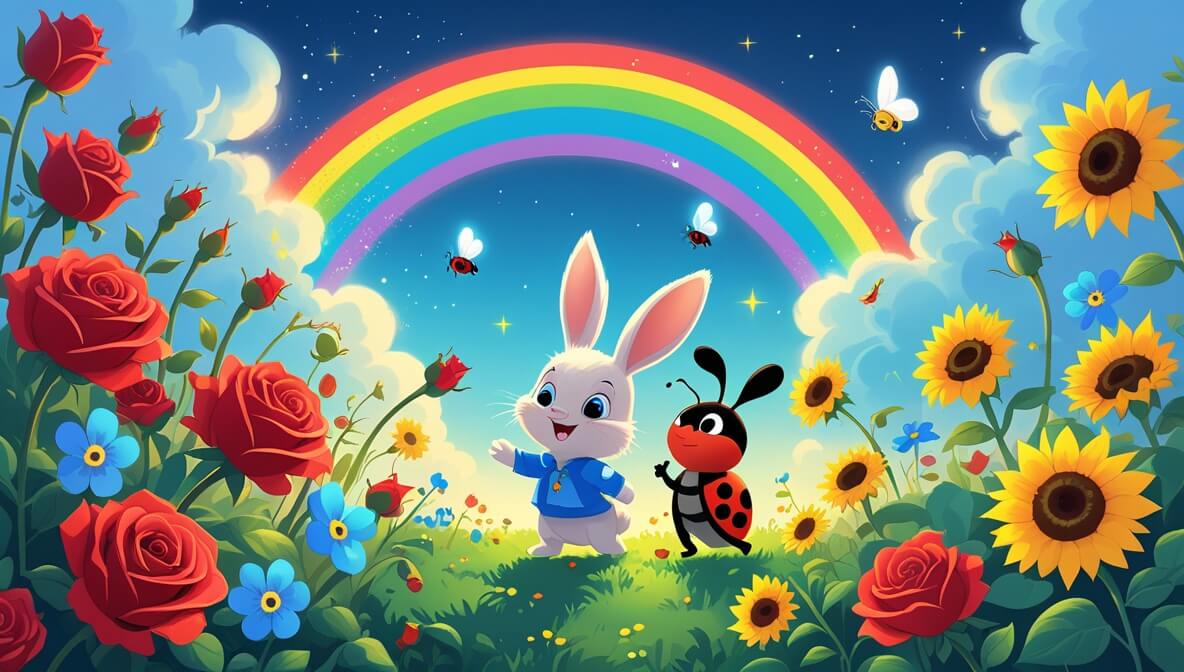This is a story about a curious little bunny named Pip who discovers a magical garden with his friend Lulu the ladybug. Together, they learn about colors, counting, and the joy of sharing.
Age Recommendation
0 – 4 years
Characters
Characters:
- Pip (a curious and friendly bunny)
- Lulu (a cheerful and helpful ladybug)
Story
Once upon a time, in a sunny meadow, there lived a little bunny named Pip. He loved to explore everything around him. One sunny morning, Pip hopped into the meadow and met his friend, Lulu the ladybug. “Let’s find something magical today!” said Pip.
The Sparkling Garden
As they hopped and flew, they stumbled upon a hidden path. Pip’s eyes widened with excitement. “Look, Lulu! A sparkling garden!” Bright flowers danced in the gentle breeze. Pip and Lulu counted the colors. “One, two, three… So many colors!” Lulu buzzed happily.
Rainbow Discoveries
The garden was filled with vibrant colors like red roses, yellow sunflowers, and blue forget-me-nots. Pip giggled, “Let’s count them!” Together, they counted to ten and laughed at the colors. Pip picked a soft, white petal and shared it with Lulu. “Sharing makes everything better,” smiled Lulu.
A Special Surprise
Suddenly, a rainbow appeared in the sky. “Wow, Lulu, look!” They both watched in awe, their hearts filled with joy. “This is the best day ever,” said Pip. Lulu agreed and whispered, “Friends make every adventure special.”
The end.
Moral of the Story
The story teaches that exploring together and sharing with friends brings joy and happiness. It also highlights the beauty of nature and the fun of learning colors and counting.
Questions to Think About
- Why did Pip and Lulu enjoy exploring the garden?
- How did Pip and Lulu share their discoveries?
- What colors did Pip and Lulu find in the garden?
- What makes a day special for Pip and Lulu?
- How can you share your favorite things with friends?
Do You Know
- Ladybugs are helpful insects because they eat garden pests like aphids.
- Rainbows are made when sunlight shines through raindrops, splitting light into different colors.
Word Explorer
- Meadow: A grassy field where flowers and animals can be found.
- Explore: To go on an adventure to discover new things.
- Petal: The colorful part of a flower.
Emotions in the Story
- Excitement: When Pip found the sparkling garden with Lulu.
- Joy: When they saw the rainbow together.
- Friendship: When they shared the petal and their adventure.
Color Your Scene
Imagine the magical garden with all the different flowers and colors. Draw Pip and Lulu discovering the garden, with the rainbow shining above them. Use bright colors like red, yellow, and blue to make the picture come alive!
Parents’ Corner
This story can help parents talk about the importance of exploration and curiosity in children. Encourage your child to notice the world around them, count objects, and identify colors. Sharing and playing with friends can also teach them the joy of companionship and the beauty of nature.











